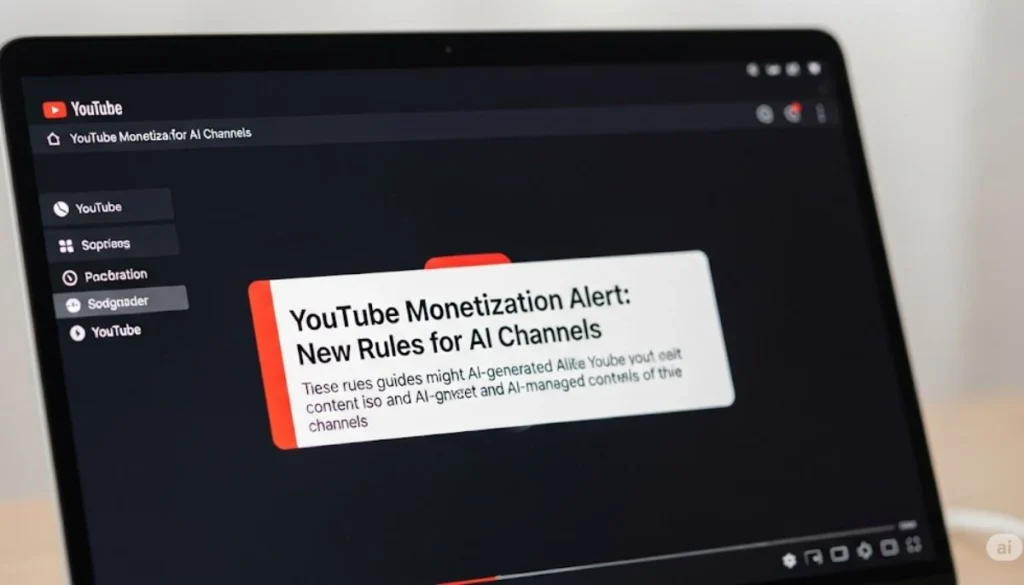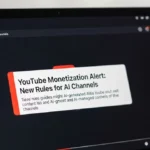A Major Shift in YouTube Monetization Content Policy
On July 15, 2025, YouTube is rolling out one of its most significant monetization policy updates in recent years. The platform, home to over 2 billion monthly users and millions of creators, is now doubling down on content quality and authenticity.
Table of Contents
This update specifically targets mass-produced, repetitive, and AI-generated content, often referred to as “AI slop.” If you’re a content creator—especially one who uses templates, automation tools, or AI-generated scripts—this update could directly impact your eligibility for the YouTube Partner Program (YPP) and future ad revenue.
What’s Changing on July 15 about YouTube Monetization?

YouTube’s updated policy introduces stricter standards for what it considers “original content.” The main highlights include:
- Repetitive, mass-produced, and auto-generated content may no longer qualify for youtube monetization.
- Channels must demonstrate human creativity, effort, or commentary to stay eligible.
- YouTube will more aggressively demonetize content that appears to be automatically generated without meaningful transformation.
The platform isn’t banning AI tools entirely. Instead, it demands that creators use these tools responsibly and transparently, ensuring that content adds genuine value.
Who Is at Risk Under the New YouTube Monetization Policy?
Several types of channels are especially vulnerable to demonetization under the new rules:
- AI-narrated videos that simply repurpose public domain or trending topics without commentary.
- Slideshow-style videos with no voiceover or narrative.
- Reaction or compilation channels that reuse content without adding analysis or unique commentary.
- Channels producing content at scale using automation or bulk publishing scripts.
Even larger creators won’t be immune—although they may benefit from more lenient manual reviews. YouTube emphasizes that originality and transformation are now the key to staying monetized.
Why YouTube Is Making This Change Now
The timing of this update isn’t random. Over the past year, YouTube has seen an explosion in content produced by AI tools and templates. This includes:
- Entire channels running on AI-generated voiceovers and visuals.
- Templated content uploaded en masse with little human involvement.
- Poor user experiences due to repetitive and low-effort videos.
YouTube’s credibility and advertising ecosystem depend on trust. As advertisers demand higher-quality and brand-safe environments, YouTube is moving quickly to protect its long-term value.
What Counts as “Transformative” or “Original” Content?
To remain eligible for monetization, creators must ensure their content shows clear human effort and transformation. According to YouTube, here are the traits of acceptable content:
- Personal commentary or storytelling
- Analytical insights or critical evaluation
- Significant scripting, editing, or visual design
- Humor, emotional context, or personal opinions
For example:
- If you use AI-generated scripts, add personal narration or video footage.
- If you compile clips, contextualize them with commentary or lessons.
- If using AI visuals, ensure they support a clearly human narrative.
Transparency Is Now Mandatory
YouTube will also monitor how AI content is disclosed. The platform’s Altered Content label must be used if you include AI-altered visuals, synthetic voiceovers, or deepfake elements.
Failure to label content properly could result in demonetization—or worse, community guideline strikes.
How Creators Can Adapt and Thrive
Here’s a strategic plan for creators to navigate the update:
1. Audit Your Channel
- Remove or unlist repetitive, template-based videos.
- Review past uploads for originality and transformation.
2. Double Down on Authenticity
- Share your voice, story, perspective.
- Use AI as a supporting tool, not the main content creator.
3. Diversify Content Formats
- Add interviews, commentary, tutorials, or live sessions.
- Mix AI tools with real-life visuals and scripting.
4. Label Altered Content Transparently
- Use YouTube’s features to disclose AI usage.
- Build trust with both the platform and your audience.
5. Prioritize Quality Over Quantity
- Focus on a few well-crafted videos over mass-uploading.
- Manual reviews will reward creators who add visible value.
Consequences of Non-Compliance
Failing to follow the updated policies could lead to:
- Immediate demonetization
- Suspension or removal from the YouTube Partner Program
- Decreased visibility in YouTube’s algorithm
- Brand trust erosion among viewers and advertisers
Creators who ignore these updates risk losing not only revenue but also long-term growth opportunities.
Conclusion: Embrace the Shift, Don’t Fear It
YouTube’s July 15 update marks a clear turning point. The platform is steering away from mass-produced content and shifting toward authenticity, creativity, and human input. While this may seem like a threat to automated workflows, it’s actually a wake-up call for creators to elevate their game.
If you’re a creator who cares about quality and long-term growth, this is your moment to stand out. Use AI wisely, but let your voice, story, and insight lead the way.
Source: thescottishsun














